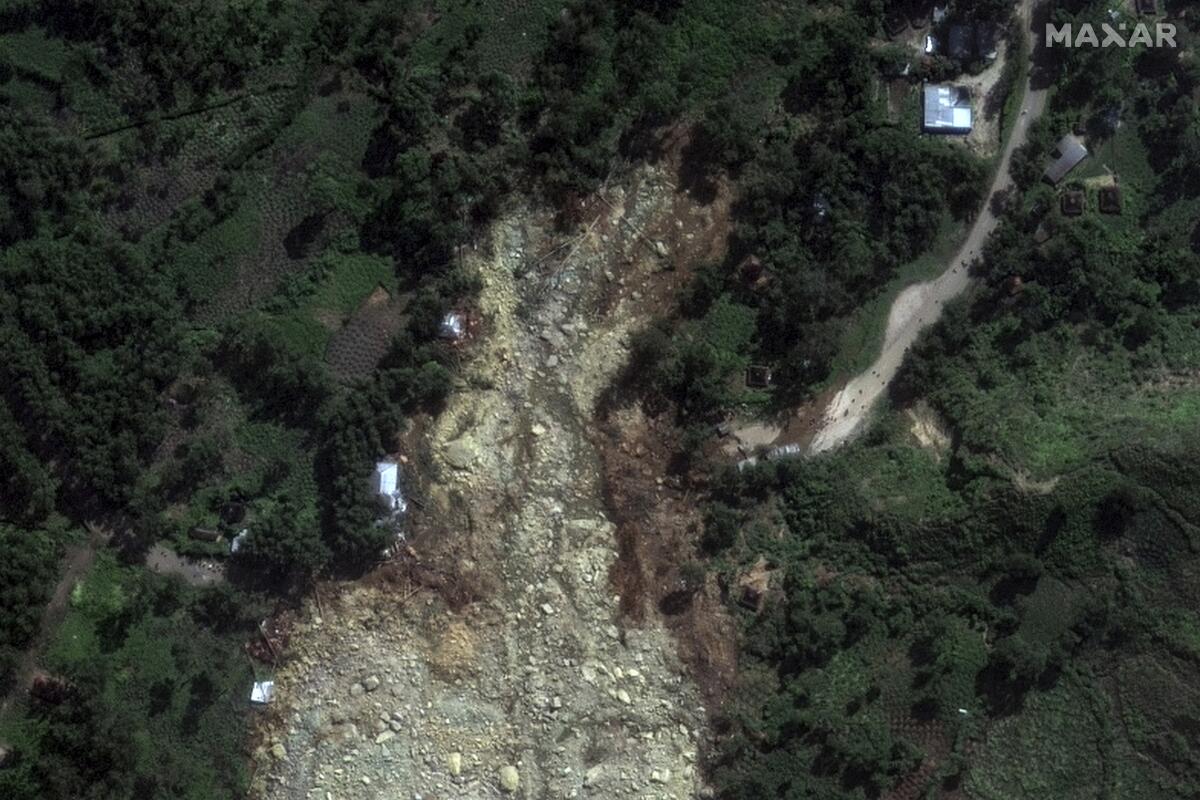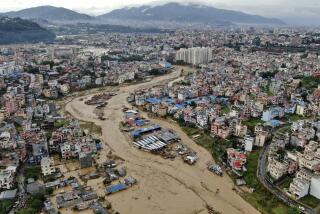At least 2,000 feared dead in Papua New Guinea landslide. These are some challenges rescuers face

- Share via
BANGKOK — The Papua New Guinea government said more than 2,000 people are believed to have been buried alive in a landslide in the South Pacific island nation, after the side of a mountain came down in the early hours of Friday morning when the village of Yambali was asleep.
The settlement is in a restive and remote area in the interior of the poor, rural nation off the northern coast of Australia, making search and rescue efforts complicated and hazardous.
The government death toll is roughly triple the U.N. estimate of 670 killed. The remains of only six people had been recovered so far.
In a letter seen by the Associated Press to the United Nations resident coordinator dated Sunday, the acting director of Papua New Guinea’s National Disaster Center, Luseta Laso Mana, said the landslide “buried more than 2,000 people alive” and caused “major destruction” at Yambali village in the Enga province.
Estimates of the casualties have varied widely since the disaster occurred, and it was not immediately clear how officials arrived at the number of people affected.
Here’s a look at some of the challenges:
Difficult access, restive population
The village of at least 4,000, but believed to be substantially larger, is in a mountainous and forested part of Papua New Guinea’s Enga province. It’s alongside a winding highway to the town of Porgera and a mine that has produced billions of dollars of gold but whose security personnel have been accused by rights groups of abuses.
The highway was covered by the landslide, effectively cutting off Porgera and the other villages past Yambali from the provincial capital of Wabag, some 35 miles from where the disaster occurred.
Emergency responders have brought aid in from Wabag, but have had to make the final 200 yards of the journey by foot over the rubble-covered highway.
Debris 20 to 26 feet deep covering an area the size of three or four football fields was being cleared exclusively by hand with shovels and picks for more than two days, until an excavator donated by a local builder arrived Sunday.
Survivors have been hesitant to allow heavy machinery to be used, however, because they do not want the bodies of their relatives harmed, said Serhan Aktoprak, the chief of the U.N. migration agency’s mission in Papua New Guinea. The donated excavator was driven away Monday morning, though it’s not clear whether that was related to locals’ objections or for another reason, he said.
Military engineers with additional heavy equipment are being transported to the disaster scene 250 miles from the east coast city of Lae and are expected to arrive Tuesday or Wednesday.
Deadly local feuds are complicating the response
Longtime tribal warfare in Enga province has not relented despite the disaster, meaning that soldiers have had to provide security for the aid convoys heading toward Yambali.
At least 26 men were killed in an ambush in February, and eight more died in a clash between two rival clans Saturday in a longstanding dispute that’s unrelated to the landslide. About 30 homes and five retail businesses were burned down in the fighting, officials said.
Convoys have been able to travel only by daylight because of the security risks, and with a two-hour drive each way, their time on site has been seriously restricted, Aktoprak said in a phone interview from Port Moresby, the country’s capital.
Approximately 25 people from the U.N., other agencies and the military have been making the daily journey. On Monday, they reported seeing burning houses and men armed with machetes along the way, Aktoprak said.
Emergency crews also face the threat of an ongoing natural disaster as the earth continues to shift in the disaster zone.
The debris is getting increasingly waterlogged from three streams covered by the landslide, making it dangerous to work on and increasing the possibility it could slide farther downhill. Communities below have already been evacuated, Aktoprak said.
“We have a situation that is getting worse and worse every moment,” he said.
What lies ahead
With the disaster ongoing and the rescue efforts still in their early stages, it’s hard to know exactly what comes next.
But with all the small farms and food gardens that sustain the village’s subsistence farming population destroyed, as well as much of its livestock, it is clear that the survivors of Yambali will need help for some time.
The village is near a river, but residents had relied on the three streams buried by the landslide for their drinking water.
Justine McMahon, country director of the humanitarian agency CARE International, said moving survivors to more stable ground was an immediate priority along with providing them with food, water and shelter. The military was leading those efforts.
In addition to people who have been evacuated from settlements lower than Yambali, Aktoprak said an estimated 6,000 have been affected by the disaster so far. If survivors end up moving to urban areas, “this will trigger additional economic and social problems.”
Porgera and other towns past Yambali on the highway are now cut off and only accessible by helicopter, and it was not immediately clear what assistance people living in those areas may need as well.
The government of Papua New Guinea formally asked Monday for more international help. The United States and Australia, a near neighbor and Papua New Guinea’s most generous provider of foreign aid, are among governments that have publicly stated their readiness to do more.
Papua New Guinea makes up the eastern half of the island of New Guinea, with the western half belonging to Indonesia. It sits in the Pacific Ocean’s so-called “Ring of Fire,” a belt of active volcanoes and frequent earthquakes.
Its population is officially around 10 million, but the U.N. has said there hasn’t been a comprehensive census for years and the actual figure could be closer to 17 million.
Rising writes for the Associated Press. AP writers Rod McGurk in Melbourne and Adam Schreck in Bangkok contributed to this report.
More to Read
Sign up for Essential California
The most important California stories and recommendations in your inbox every morning.
You may occasionally receive promotional content from the Los Angeles Times.










